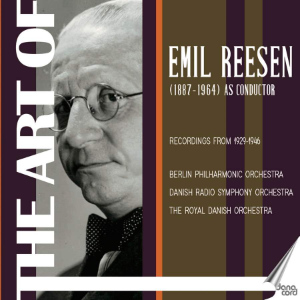
Emil Reesen (conductor)
The Art of Emil Reesen As Conductor
Wandy Tworek (violin)
The Danish State Radio Symphony Orchestra
The Royal Orchestra, Copenhagen (Kuhlau, Clarke)
Berlin Philharmonic Orchestra (Lange-Müller Renaissance; Gade,
Lumbye, Nielsen Maskarade)
rec. 1929-46, Copenhagen and Berlin
No texts
DANACORD DACOCD958 [79]
The companion disc to this latest Danacord release is one devoted to Emil Reesen’s compositions in recordings from the 1950s (review) in which a good number of performances are conducted by Reesen himself, who was immensely popular between the wars. This new release goes one better in that respect in that everything is conducted by Reesen though the repertoire is largely popular and Nordic. That said, there is some real historical value to the earliest recordings in particular, given that the 1929 Columbia discs apparently represent the earliest Danish orchestral recordings that exist. The first is a 78 pairing of ballet extracts from Gade and Lumbye – the strings are rather thin but the playing is stylish, and there’s a fine first trumpet in the ranks of the Danish State Radio Symphony.
From this tentative beginning, the director of radio, Emil Holm, who was not initially much interested in recording, allowed the orchestra further ventures in the studio. Therefore, the following year the Danish State recorded a patriotic disc – well, one couldn’t get much more patriotic than the Danish National Anthem, Hans Ernst Krøyer’s Der er et yndigt Land. It was backed by the country’s ‘second national anthem’, Ditlev Ludvig Rogert’s equally rousing Kong Christian stod ved højen Mast, an anthem reserved more specifically for the Danish royal house and the military.
After a representative ballet pairing and the two anthems, the orchestra was recorded more frequently though the repertoire continued to be brief excerpts from larger-scaled works. Reesen was an adept at this, proving a natural Kuhlau conductor, full of naturally bracing rhythms and felicitous wind detail. This all-round competence ensured that a potpourri from Kulhau’s The Elf Hill, with tremulous Else Brems and light-toned bass Holger Byrding, turned out well. He was also good at the Viennese allure of Johann and Josef Strauss.
In September 1940, five months after Denmark’s occupation, he went to Berlin to direct the Berlin Philharmonic, a politically regrettable decision. In what was clearly no coincidence he reprised his first ever coupling with his Danish Radio forces, Gade’s Polonaise and Bridal Waltz from the ballet ‘Et Folkesagn’ and added the stormy romance of Lange-Müller’s Prelude to the play ‘Renaissance’ and the larger-scaled Lumbye Drømmebilleder (Dream Pictures), a very attractive tone poem, full of personality and crisp attacks. The Berlin orchestra is recorded with much greater amplitude and technical finesse, at least in comparison with the 1929 Danish sides. Reesen soon realised the error of his ways and began conducting at patriotic rallies in Copenhagen and seems to have emerged with reputation intact.
In 1940 he also recorded popular extracts from Nielsen’s Maskarade and after the war he continued with a few more pieces of a decidedly light kind; Jeremiah Clarke (nothing timid about this march), Jacob Gade’s Jalousie and Emmerich Kálmán’s Komm’ Zigany from ‘Gräfin Maritza’, the last two featuring the flexible fiddler, Wandy Tworek.
There’s nothing much to get one’s symphonic teeth into here but if one enjoys lighter and popular Danish repertoire there’s much enjoyment to be had listening to Reesen’s idiomatic and galvanising conducting. Fine notes as usual from Danacord are accompanied by good transfers. These are all noted as first CD releases but that certainly doesn’t relate to Jalousie, at least, as Danacord has already reissued it in their Wandy Tworek retrospective (review).
Jonathan Woolf
Help us financially by purchasing from


Contents
Niels W. Gade (1817-1890)
From the ballet ‘Et Folkesagn’: Polonaise: Brudevals (Bridal Waltz) (1854)
H.C. Lumbye (1810-1874)
From the ballet ‘Livjægerne på Amager’: Finale-galop (1871)
Hans Ernst Krøyer (1798-1879)
Der er et yndigt Land (1821)
Ditlev Ludvig Rogert (1742-1813)
Kong Christian stod ved højen Mast (1779)
Friedrich Kuhlau (1786-1832)
From “Elverhøj” (The Elf Hill) Op. 100; Act IV: Ballet – Agnetes drøm: Elverdans (Elf’s Dance): Act V: Kransedans (Garland Dance): Ecossaise (1828)
P.E. Lange-Müller (1850-1926)
From ‘Der var Engang’; Prelude (1887)
Johann Strauss II (1825-1899)
Rosen aus dem Süden, Op. 388 (1880)
Josef Strauss (1827-1870)
Mein Lebenslauf ist Lieb’ und Lust, Op.263 (1869)
Friedrich Kuhlau
Potpourri From ‘Elverhøj’, (The Elf Hill) Op. 100 (1828)
Else Brems (mezzo-soprano): Holger Byrding (bass)
P.E. Lange-Müller
Prelude to the play, ‘Renaissance’ (1901)
Niels Gade (1817-1890)
From the ballet ‘Et Folkesagn’: Polonaise: Brudevals (Bridal Waltz) (1854)
H.C. Lumbye
Drømmebilleder (Dream Pictures) (1846)
Carl Nielsen (1865-1931)
From ‘Maskarade’: Overture: Hanedans (The Dance of the Cockerels) (1904-06)
From the play ‘Moderen’ (The Mother), Op.41: Prelude, 7th Scene: March (1921)
Jeremiah Clarke (1674-1707)
Prins Jørgens March (Prince of Denmark’s March; Trumpet Voluntary) (1699)
Jacob Gade (1879-1963)
Tango Tzigane ‘Jalousie’ (1925)
Emmerich Kálmán (1882-1953)
Komm’ Zigany. From ‘Gräfin Maritza’ (1924)


















